Hey!
Did I catch your attention? How long did it take? What exactly happened that allowed you to register this thought? Well, now we are going to find out.
Previously, we discussed the elements of the brain. Now we are going to go a bit deeper to see how this cognitive process works! Are you ready? Make sure you have your thinking caps on!
Note: Be sure to read How the Brain Affects Our Behavior as a prerequisite to this article.
The Central Nervous System
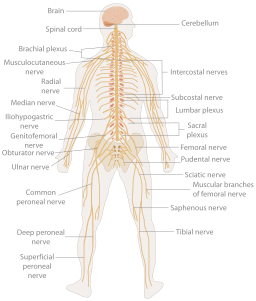
Your brain does not act alone. It communicates with your spinal cord to coordinate your body’s actions. How it does this is complex; however, we will keep it simple.
Similar to data that is communicated through the Internet, the central nervous system does the same thing within our bodies. It is an information processing system with many ‘wheels’ that regulate how we think and move. In other words, our brain coordinates with the other parts of our body so that all these components work in conjunction with each other.
For example, you decide to get something to eat because your brain has notified you that you are hungry, but who told your brain that you are hungry? Well, most would agree, that t would be your stomach. Now that you know you are hungry, you decide to walk to a restaurant, so your brain tells your legs to start walking. You open the restaurant door and, you guessed it, your brain just spoke to your hands. This process goes on 24/7, even when you are sleeping.
Simple Cell Creatures
There are so many cells in the human body that it is almost as mind-boggling as the universe itself, but let’s see if we can make sense of it all.
When you look at a building, you look at it as one whole unit, never thinking about seeing it brick by brick. Now, what if we were to look at living organisms that way? Starting with the simple amoeba, we decide to look at it as cells or by each cell that puts it together; however, the amoeba is made up of only one cell, so we can’t do that with this fellow.
Let’s move on to more complicated creatures like tardigrades, which are tiny, almost microscopic animals that live in moist and watery areas. They are simple, but almost immortal creatures. They can live in just about any environment. Water, land, and even outer space, are very hard to kill (not sure why anyone would want to do that though).
With that said, these creatures have up to 40,000 cells, and this is our point. From the ameba to the tardigrade, there are 40,000 more of these tiny organisms in the tardigrade and that is what makes this animal look and live the way it does. But still, 40,000 is not a lot compared to the next species we are going to discuss.
Cells in the Human Brain
100,000,000,000 cells. That’s 100 billion! In comparison, this amount equates to 50 times more than the number of stars in our Milky Way galaxy. No wonder we have intelligence, although some could argue that premise :-).
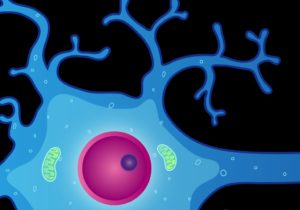
Of these 100 billion cells, 86% are neurons, also known as nerve cells. These cells’ function is to transmit information from/to the brain and from/to the central nervous system. They do this by electrochemical means, which is the process where electrons move from one location to another. Yes, our brain cells have electrons.
When electrons move from one place to another, they are transmitting information, albeit, it is information that moves in extremely tiny amounts, but it is a transmission of information that is occurring. Neurons can transfer these tiny messages an inch or less or several feet, depending upon where the receiving neuron is located.
What Neurons Are Made of
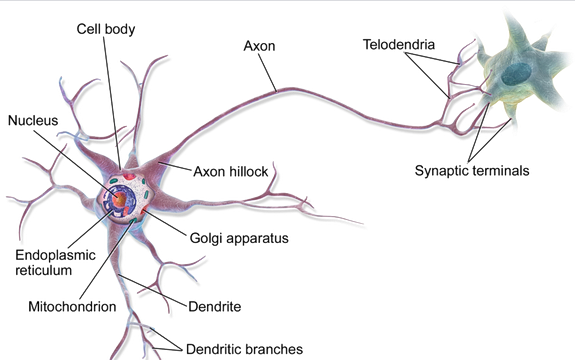
Cell Body AKA Soma
This is the essential part of the nerve cell that contains all the necessary components needed for the cell to function. It is somewhat analogous to the heart in our bodies. The soma contains the nucleus, ribosomes (which build proteins, and mitochondria, the component which makes energy). Just like the heart, if the soma fails, then the rest of the cell fails with it.
Axon
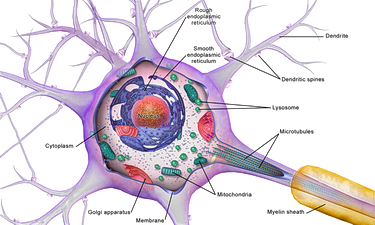
Think of it as a pipe. The electrical impulse (message) moves down this pipe (or up). In scientific terms, it is the action potential that allows the messages to be projected away from the soma and travel down the axon where it is expelled through the dendrites.
There is an external material that the axons contain. Like a road that contains gravel and a road that is finally paved, some axons are covered with this material which is a thin layer of myelin sheath, while others do not have this sheath component and are called non-myelinated.
The purpose of the myelin sheath is to allow the messages to travel faster, like a car traveling down a finally paved road in contrast to a non-myelinated axon (gravel road) where the message takes longer to reach its destination. In scientific terms, myelin helps to speed the transmission of the nerve impulses down the axon.
Myelinated neurons are those that are located in the peripheral nerves – neurons that are outside of the brain and non-myelinated neurons are the ones that are located within the brain and spinal cord. Indeed this makes sense since those neurons that are outside of the brain have a longer distance to travel than those that are millimeters away from each other inside the brain.
Dendrites AKA Nerve Endings
Like an octopus’s arms, they branch out from the end of the axon to make electrical contact with the destination neuron.
If you are familiar with electronics, the transmission of the messages is actually the movement of electrons from one cell to another.
Conclusion
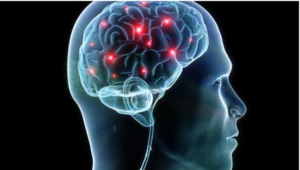
The nerve cells communicate or talk (send information) to other nerve cells via a series of electronic pulses that originate in the nucleus (sona) and proceed through the axon to the dendrites where they are picked up by another neuron. Thus, we have the processing of information that goes on continuously.
The speeds at which the receptors of the dendrites receive and transmit information have not been scientifically proven to complete accuracy; however, scientists estimate that the unmyelinated nerve cells in this gray matter that we call the brain travel around 11 inches per second. So to keep it simple for us human mortals, we can say that the speed of a message is instantaneous, at least within our heads.
Putting this all together, the processing of information in the brain of, say, deciding to turn on the TV can involve hundreds of thousands of nerve cells and be equated to just one thought; thus, neurons are the mechanisms that transmit our thoughts! What do you think of that?
